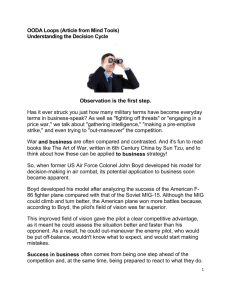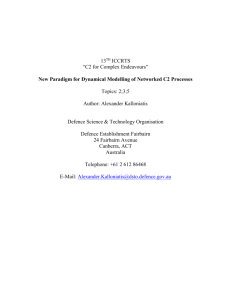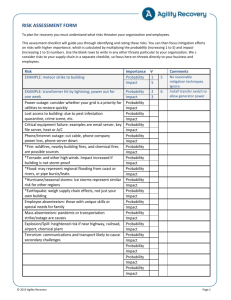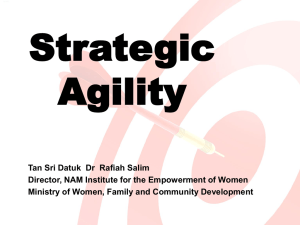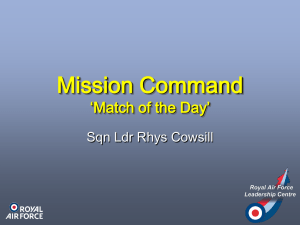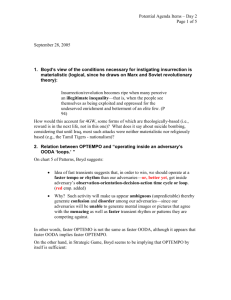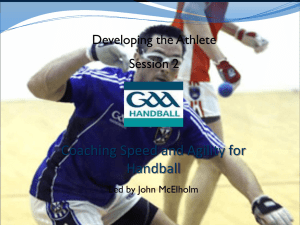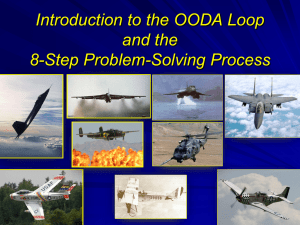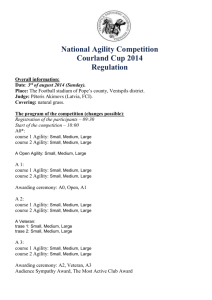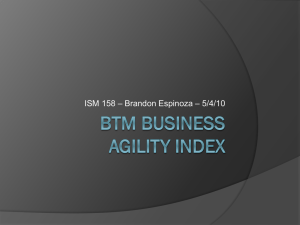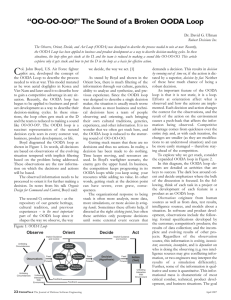Applying the OODA Loop to Accelerate Your Decision Making
advertisement
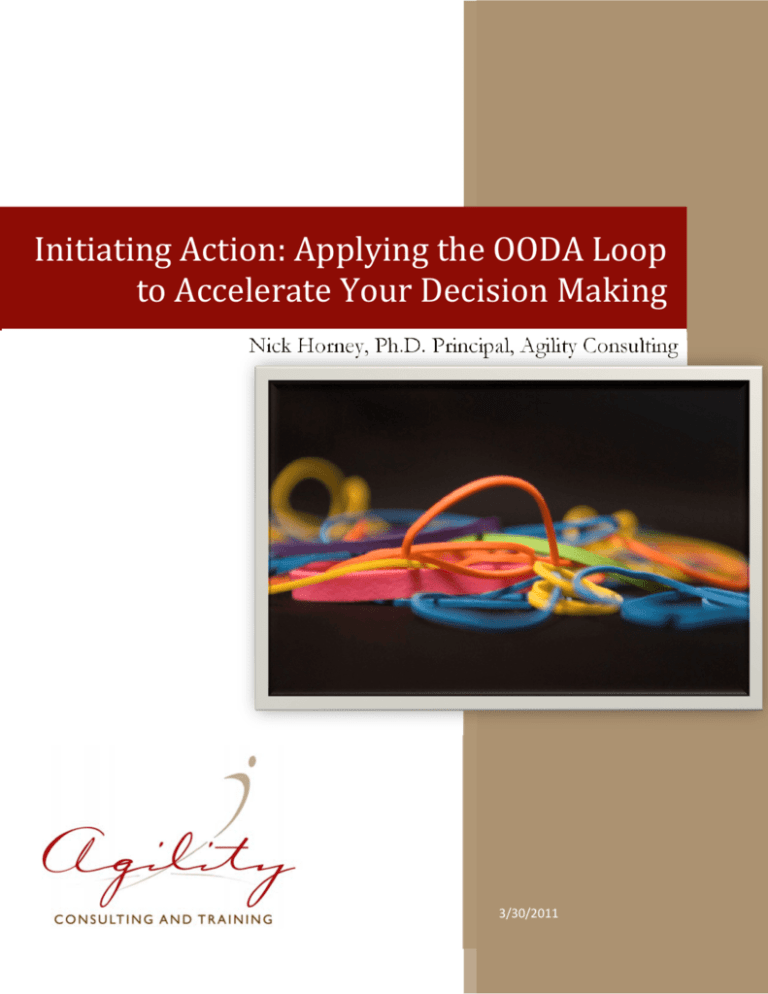
InitiatingAction:ApplyingtheOODALoop toAccelerateYourDecisionMaking Nick Horney, Ph.D. Principal, Agility Consulting 3/30/2011 OODA Loop “In order to win, we should operate at a faster tempo or rhythm than our adversaries” . . . John Boyd, USAF Retired T he OODA loop (Observe, Orient, Decide, Act) is a model that was created by USAF Col. John Boyd. It was originally designed for Koreanera fighter pilots as a way to understand conflict and provide military leaders with a model or method for making decisions and assessing their impact. John Boyd, USAF Retired The execution of the decision making process may be viewed as involving the cycling through of four distinctive but interdependent stages: 1) OBSERVATION, or absorbing information from the environment by all possible means; 2) ORIENTATION, or placing this information into a matrix of human understanding and experience; 3) DECISION, or selecting a subsequent course of action based upon the likelihood of either offensive achievement or defensive nullification; and 4) ACTION, or attempting to operationalize or carry out the previously conceived decision. Collectively, these stages have come to be known as an OODA loop. The OODA loop has been employed as an effective tool by the U.S. Department of Defense to build an adaptable fighting force. The premise of the model is that decision-making is the result of rational behavior in which problems are viewed as a cycle of Observation, Orientation (situational awareness), Decision Making, and Action. It also has been used by Intel, Nokia and other corporations to produce a competitive advantage in the marketplace. Since we constantly interact and interpret, our environment is in constant flux. Listening to what others say inside and outside our organization, observing changing market conditions and our interaction with or response to those changes all demand leadership and organizational agility. Initiating Action means shortening the time needed to make decisions, to plan, coordinate and communicate. OODA speed is a critical component of Agility, and especially so in environments that are large, complex, nonlinear, unpredictable and continuously changing. These are the precise characteristics that mark global business competition today … and that will only continue to intensify in the future. Agility Consulting and Training, LLC - 2011 Page 2 OBSERVE. When an enterprise is engaged in conflict (as in determining how to lead, or respond to, a competitive change initiative, e.g., drive a market; blunt a competitor's strategic thrust; employ a new technology; etc.), its first activity is to OBSERVE the situation - that is, to take in raw and unprocessed data about its own status, its marketplace, its customers, its competitors, its partners, regulators, channels and operational environment. Sometimes an enterprise actively seeks that information (in today's jargon, "pulls" information): sometimes that information is thrust ("pushed") upon it. In the Internet/e-Business world, both the volume of available data and a richness of divergent forms of that data, are available on a continuous, realtime basis. Experience plays a large role in what we observe and our conclusions about our environment. If you work at Wal-Mart, it’s all about low cost, whereas if you work at Nordstrom, it’s all about customer service. All of this gets filtered and sorted as we orient to our past experience. Since business is an everchanging situation, previous experiences and new information allow for adjustments in orientation. Observe ORIENT. Having OBSERVED the situation, the enterprise next ORIENTS itself that is, performs certain analyses and makes certain estimates, assumptions and judgments about the situation in order to create a cohesive mental model or image of the total environment. In simple terms, the enterprise attempts to determine what the changing/changed situation means to it and how it will be impacted. The orientation phase of any decision cycle is the linchpin of decision making. It involves collecting, integrating, and processing all available information and data to ascertain “ground truth.” In establishing our orientation in any life environment the time it takes to gather and process information is as important as the manner in which that information is gathered. A large part of the challenge is trying to separate fact from fiction, certainties from assumptions. We have to process information, determine our orientation, make decisions, and act before our opponents go through the same four-step cycle. Additionally, we cannot be satisfied if we do this one or two times — staying ahead of our opponents requires strenuous, constant effort to achieve faster and more effective OODA loops. Orient DECIDE. Based on ORIENTATION, the enterprise next DECIDES what to do regardless of whether that decision is self-contained or involves others (including customers, suppliers, partners, regulators and even competitors), and whether that decision takes the form of an immediate action or involves the creation of a deliberate plan and a delayed response. The decision part of the loop is where leadership shows up, not by having all the answers but by leading the organization in determining a course of action. Differing assessments, diverging points of view and open discussions all characterize the decision phase. Having specific goals, measurements and a process for gathering information to feed the observation phase all should be part of the decision process, especially when working to reorient people to new ways of thinking or acting. Speed is key for an effective application of the OODA Loop. The whole purpose behind using the loop is to increase the velocity at which decisions can be made in an effort to produce action consistently and effectively. Decide ACT. Finally, the enterprise puts its DECISION into ACTION. This includes disseminating the decision, supervising its execution, and monitoring the results of the ACTION through feedback. This completes one iteration of the OODA cycle, and returns the enterprise to the OBSERVATION phase. Action is more than just doing something. It’s taking account of what you are doing with the result in mind. It’s observing the result and making an assessment about whether you accomplished the intended result and, if not, what breakdowns occurred and how to overcome them. Act Agility Consulting and Training, LLC - 2011 Page 3 The OODA loop depends completely upon tactical, operational, and strategic agility. We must not only think faster than our opponent; we must also move faster than him. Movement by itself can be fruitless or even counterproductive. If Newtonian momentum is defined as mass multiplied by velocity, we best define agility in the information age as the combination of being focused, fast and flexible. To take full advantage of rapid technological change requires mental and physical agility in both the planning room and in the business environment. In any competitive environment, the enterprise that can consistently and effectively cycle through the OODA process faster - that is, can maintain a higher tempo of actions - than its competitors gains an ever-increasing advantage with each cycle. With each iteration, the slower competitor falls further behind and becomes increasingly unable to cope with the continuously deteriorating situation. With each cycle, the slower competitor's actions become less relevant to the situation. Since business is competitive, it is not absolute speed that matters, but rather speed relative to one's customers and competitors. The aim is to be faster in OODA processing than one's competitor(s), and to lead or respond to challenges and opportunities within a customer's time requirements with effective, customized solutions. Focused solutions provide significantly greater customer value than is achievable through the production and delivery of commodity-type or non-customized products and services. Agility Consulting and Training, LLC - 2011 Page 4 About Agility Consulting Since 2001, we have been building research and body of knowledge around what drives true organizational agility. What differentiates those organizations, teams and leaders that are able to sense and respond better and faster than others in this increasing turbulent world we have? Our research led to the development of The Agile Model® which embodies five key drivers that enable organizational, team and individual leadership agility. This model has been recognized by The American Management Association as well as highlighted in a 2008 book entitled “Human Resource Transformation ….” To learn more about how to apply The Agile Model® to your business please go to our website noted below. Nick Horney, Ph.D. & Tom O’Shea, CMC Principals Agility Consulting & Training, LLC 1901 Rosevilla Lane Greensboro, NC 27455 W: 336-286-7250 Email: NickHorney@AgilityConsulting.com or Tom@AgilityConsulting.com Website: www.AgilityConsulting.com Agility Consulting and Training, LLC - 2011 Page 5
